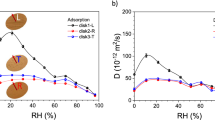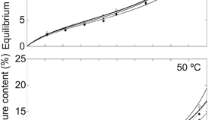Abstract
The wettability of Scots pine veneers was investigated with different approaches using the Wilhelmy plate method. The probe liquids were water and octane, which differ; in that, water is able to swell the wood sample, whereas octane does not. Novel approaches based on the Wilhelmy plate method to study wettability, liquid penetration, and swelling behavior of wood veneers are introduced. First, immersion to constant depth was performed, and liquid uptake with time was evaluated. Different kinetic regimes, the fastest one associated with contact angle changes and the slowest regime associated with liquid sorption by capillary and diffusion, were observed. Two other approaches, imbibition at constant depth (with initial deeper immersion) and full immersion, were utilized in order to keep the contact angle constant during measurements. Dynamic wettability studies were done by a multi-cycle (10–20 cycles) Wilhelmy method. Based on this, the time-dependent swelling of wood and changes in sample perimeter could be obtained. Generally, water showed higher absorption than octane. In all wettability studies, and for both probe liquids, the penetration process starts with a fast initial sorption, which is followed by swelling in the case of water.










Similar content being viewed by others
References
Ayrilmis N (2011) Effect of fire retardants on surface roughness and wettability of wood plastic composite panels. Bioresources 6(3):3178–3187
Berg JC (1993) Wettability. Surfactant science series, vol 49. Marcel Dekker, New York
Brugnara M, Volpe CD, Maniglio D, Siboni S, Negri M, Gaeti N (2006) Wettability of porous materials, I: the use of Wilhelmy experiment: the cases of stone, wood and non-woven fabric. Contact Angle Wettability Adhes 4:115–141
Bryne LE, Wålinder MEP (2010) Ageing of modified wood. Part 1: wetting properties of acetylated, furfurylated, and thermally modified wood. Holzforschung 64(3):295–304
Casilla RC, Chow S, Steiner PR (1981) An immersion technique for studying wood wettability. Wood Sci Technol 15(1):31–43
de Meijer M, Haemers S, Cobben W, Militz H (2000) Surface energy determinations of wood: comparison of methods and wood species. Langmuir 16(24):9352–9359
Englund F, Bryne LE, Ernstsson M, Lausmaa J, Wålinder M (2009) Spectroscopic studies of surface chemical composition and wettability of modified wood. Wood Mater Sci Eng 4(1–2):80–85
Garcia R, Cloutier A, Riedl B (2006) Chemical modification and wetting of medium density fibreboard panels produced from fibres treated with maleated polypropylene wax. Wood Sci Technol 40(5):402–416
Gardner DJ, Generalla NC, Gunnells DW, Wolcott MP (1991) Dynamic wettability of wood. Langmuir 7(11):2498–2502
Hakkou M, Pétrissans M, El Bakali I, Gérardin P, Zoulalian A (2005a) Wettability changes and mass loss during heat treatment of wood. Holzforschung 59(1):35–37
Hakkou M, Pétrissans M, Zoulalian A, Gérardin P (2005b) Investigation of wood wettability changes during heat treatment on the basis of chemical analysis. Polym Degrad Stab 89(1):1–5
Hoffman RL (1975) A study of the advancing interface. I. Interface shape in liquid—gas systems. J Colloid Interface Sci 50(2):228–241
Klungness JH (1981) Measuring the wetting angle and perimeter of single wood pulp fibers: a modified method. Tappi 64(12):65–66
Liptáková E, Kúdela J (1994) Analysis of the wood wetting process. Holzforschung 48(2):139–144
Lu JZ, Wu Q (2006) Surface characterization of chemically modified wood: dynamic wettability. Wood Fiber Sci 38(3):497–511
Mantanis GI, Young RA (1997) Wetting of wood. Wood Sci Technol 31(5):339–353
Mohammed-Ziegler I, Hórvölgyi Z, Tóth A, Forsling W, Holmgren A (2006) Wettability and spectroscopic characterization of silylated wood samples. Polym Adv Technol 17(11–12):932–939
Neumann AW, Good RJ (1979) Chapter 2. Techniques of measuring contact angles. In: Good RJ, Stromberg RR (eds) Surface and colloid science volume II. Plenum Press, New York, pp 47–51
Nussbaum RM, Sterley M (2002) The effect of wood extractive content on glue adhesion and surface wettability of wood. Wood Fiber Sci 34(1):57–71
Petrič M, Knehtl B, Krause A, Militz H, Pavlič M, Pétrissans M, Rapp A, Tomažič M, Welzbacher C, Gérardin P (2007) Wettability of waterborne coatings on chemically and thermally modified pine wood. J Coat Technol Res 4(2):203–206
Pétrissans M, Gérardin P, El Bakali I, Serraj M (2003) Wettability of heat-treated wood. Holzforschung 57(3):301–307
Shen Q, Nylund J, Rosenholm JB (1998) Estimation of the surface energy and acid-base properties of wood by means of wetting method. Holzforschung 52(5):521–529
Shupe TE, Hse CY, Choong ET, Groom LH (1998) Effect of wood grain and veneer side on loblolly pine. For Prod J 48(6):95
Sinn G, Sandak J, Ramananantoandro T (2009) Properties of wood surfaces—characterisation and measurement. A review. COST Action E35 2004–2008: wood machining—micromechanics and fracture. Holzforschung 63(2):196–203
Son J, Gardner DJ (2004) Dimensional stability measurements of thin wood veneers using the Wilhelmy plate technique. Wood Fiber Sci 36(1):98–106
Tretinnikov ON, Ikada Y (1994) Dynamic wetting and contact angle hysteresis of polymer surfaces studied with the modified Wilhelmy balance method. Langmuir 10(5):1606–1614
Volpe CD, Fambri L, Siboni S, Brugnara M (2010) Wettability of porous materials III: Is the Wilhelmy method useful for fabrics analysis? J Adhes Sci Technol 24(1):149–169
Wålinder MEP (2002) Study of lewis acid-base properties of wood by contact angle analysis. Holzforschung 56(4):363–371
Wålinder MEP, Johansson I (2001) Measurement of wood wettability by the Wilhelmy method. Part 1. Contamination of probe liquids by extractives. Holzforschung 55(1):21–32
Wålinder MEP, Ström G (2001) Measurement of wood wettability by the Wilhelmy method. Part 2. Determination of apparent contact angles. Holzforschung 55(1):33–41
Wang S, Zhang Y, Xing C (2007) Effect of drying method on the surface wettability of wood strands. Eur J Wood Prod 65(6):437–442
Wilhelmy J (1863) Über die Abhängigkeit der Kapillaritäts-Konstanten des Alkohols von Substanz und Gestalt des benetzten festen Körpers. Ann Physik 119:177–217
Winfield PH, Harris AF, Hutchinson AR (2001) The use of flame ionisation technology to improve the wettability and adhesion properties of wood. Int J Adhes Adhes 21(2):107–114
Xie X, Morrow NR (2000) Contact angles on quartz induced by adsorption of heteropolar hydrocarbons. In: Drelich J, Laskowski JS, Mittal KL (eds) Apparent and microscopic contact angles. VSP BV, The Netherlands, pp 129–145
Acknowledgments
The Nils and Dorthi Tröedsson Foundation for Scientific Research is thanked for financial support within the sustainable wood modification PhD project and for the adjunct professorship at KTH for Agne Swerin.
Author information
Authors and Affiliations
Corresponding author
Rights and permissions
About this article
Cite this article
Sedighi Moghaddam, M., Claesson, P.M., Wålinder, M.E.P. et al. Wettability and liquid sorption of wood investigated by Wilhelmy plate method. Wood Sci Technol 48, 161–176 (2014). https://doi.org/10.1007/s00226-013-0592-1
Received:
Published:
Issue Date:
DOI: https://doi.org/10.1007/s00226-013-0592-1




